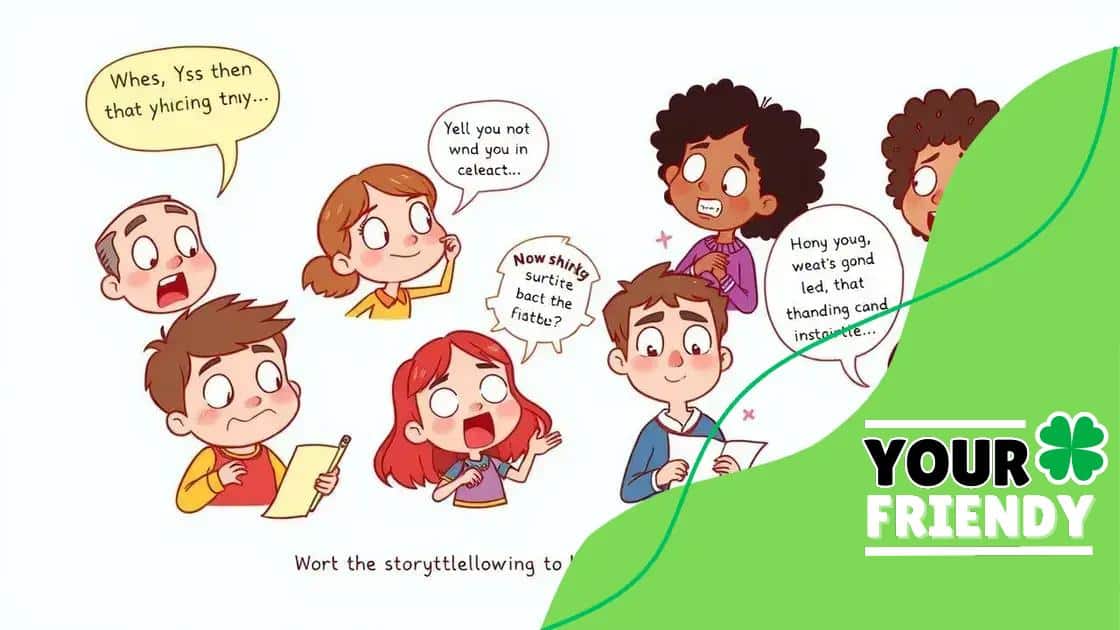Humor to relieve dramatic tension: A guide to effective storytelling

Anúncios
Balancing humor and drama in storytelling enhances audience engagement, using techniques like character traits, timing, and situational irony to create a dynamic emotional experience.
Humor to relieve dramatic tension isn’t just a technique; it’s a powerful tool that can transform your storytelling. Ever noticed how a well-timed joke can change the mood in a scene? Let’s dive into this fascinating interplay.
Anúncios
Understanding dramatic tension
Understanding dramatic tension is essential for creating engaging narratives. It keeps the audience invested in the story. So, what exactly is dramatic tension? It’s the feeling of anticipation and uncertainty that arises when characters face challenges. This tension can make a story exciting and relatable.
Elements of Dramatic Tension
Dramatic tension can be broken down into several key elements. Each element works together to create a gripping story. Here are a few vital components:
- Conflict: The central struggle between opposing forces drives the story forward.
- Stakes: High stakes make the outcome more significant, urging readers to keep turning the pages.
- Time Pressure: A looming deadline or race against time increases urgency and heightens tension.
- Character Goals: Clear goals for characters create an emotional connection, making readers care about their success or failure.
As the story progresses, these elements evolve. Characters encounter obstacles that test their resolve. This not only builds tension but also deepens our understanding of their motivations. We start to feel for them as they navigate their challenges.
Anúncios
Creating Moments of Tension
To effectively deliver dramatic tension, writers often use techniques like cliffhangers and unexpected twists. These strategies keep the audience guessing and enhance their emotional investment in the plot. Just think of a time when a cliffhanger made you gasp! Heightened emotions and suspense draw the reader in, making it hard to put the book down.
Furthermore, balancing tension with moments of relief through humor or lighter scenes can be equally important. This allows the audience to breathe while still maintaining interest in the story. It’s this ebb and flow that makes a narrative captivating and engaging.
Understanding dramatic tension enriches storytelling. The journey of complicating emotions allows the audience to experience a spectrum of feelings. This investment in the characters and plot ultimately rewards the reader with a fulfilling experience.
The role of humor in storytelling
The role of humor in storytelling is often underestimated. It can serve as a powerful tool to connect with the audience, making narratives more relatable. When humor is used effectively, it creates moments of relief amidst tension, allowing readers or viewers to breathe.
Enhancing Engagement
Humor can transform a heavy storyline into something more digestible. It breaks up intense scenes and gives the audience a chance to reflect before diving back into emotional depths. Using humor keeps the narrative flowing smoothly.
- Relates to the audience: Laughter can draw people in and create a shared experience.
- Balances the tone: Integrating lighthearted moments helps balance serious themes.
- Builds character depth: A character’s sense of humor often reveals more about their personality, making them more relatable.
Moreover, humorous dialogue can provide insight into character relationships, showcasing their dynamics in a playful manner. When characters exchange witty banter, we see their personalities shine. This adds layers to the story, engaging the audience further.
Techniques for Incorporating Humor
There are various techniques to weave humor into storytelling. For instance, using irony or clever wordplay can elicit laughter in the most unexpected moments. Visual gags can also enhance humor, especially in visual mediums. Think of slapstick moments or funny facial expressions that emphasize the absurdity of a situation.
Another effective way to create humor is through character quirks. A serious character might have a hidden silly side, surprising everyone at crucial moments. This can lead to humorous situations that illustrate their growth throughout the narrative.
Ultimately, the role of humor in storytelling is to enhance connection. It entertains, provides insight, and adds an essential layer to any narrative, ensuring that the audience remains engaged throughout the journey.
Techniques for incorporating humor

Techniques for incorporating humor into your storytelling can significantly enhance your narrative. Using humor effectively helps to engage your audience while balancing tension and emotion. Let’s explore some of the most effective methods to add humor seamlessly into your story.
Wordplay and Puns
One of the simplest yet effective techniques is the use of wordplay and puns. Clever language can provoke laughter and lighten a scene. Writers can toggle between serious and silly tones, using puns to emphasize a character’s personality or a situation’s absurdity.
- Puns: A humorous play on words can add a light touch.
- Double entendres: These can create layered meanings that entertain.
- Exaggerations: Over-the-top descriptions can add humor to serious scenarios.
Another effective approach is to create **situational humor**. This arises from characters interacting with their environment in unexpected ways. Think about comical miscommunications or characters getting caught in hilarious predicaments. This type of humor often feels spontaneous and relatable, making it easy for audiences to connect with the characters.
Character Quirks
Incorporating character quirks can also bring humor to your story. Every character should have unique traits that can lead to funny scenarios. A serious character who suddenly reveals a silly side can catch the audience off guard.
Consider how different personalities clash:
- A joker: Always ready with a bad joke, even in serious situations.
- A straight man: A character who reacts seriously to the chaos around them can amplify the humor.
- Odd habits: Unique habits or obsessions can decrease the dramatic tension and add laughter.
Another strategy is the use of **timing**. The timing of a joke can make all the difference. A well-placed punchline or comedic pause can maximize the humor in a scene. This is especially true in dialogue, where timing can enhance a character’s wit significantly.
In summary, incorporating humor into storytelling is an art that requires a blend of creativity and strategy. By using these techniques, writers can create engaging narratives that entertain and resonate with their audience, balancing moments of tension with laughter.
Examples of humor in dramatic contexts
Examples of humor in dramatic contexts show how laughter can coexist with serious themes. Many stories use humor to create a balanced emotional experience for the audience. This section highlights some well-known examples.
Classic Literature
In classic literature, humor often serves as a tool to develop characters and lighten serious moments. For instance, in Shakespeare’s plays, clever wordplay can be found in the most unexpected places. His use of the fool character often provides comic relief, helping audiences cope with dramatic tension.
- Twelfth Night: Features humor through mistaken identities and playful banter.
- Hamlet: The graveyard scene provides humor amidst tragedy with the jester, Yorick.
- A Midsummer Night’s Dream: Mixes fantasy and humor to comment on love and relationships.
In modern narratives, humor functions similarly. Movies and television shows often juxtapose dramatic moments with quick-witted dialogue or absurd situations. This creates a rhythm that maintains the audience’s interest.
Film and Television
Consider movies like The Princess Bride, where characters deliver humorous lines even amidst peril. The blend of drama and comedy invites viewers to invest emotionally while still allowing moments of laughter. When the hero faces daunting challenges but also cracks jokes, it lightens the mood.
In television, shows like This Is Us expertly balance heartfelt moments with laughter. Characters share inside jokes and light-hearted exchanges during serious discussions. This not only develops their relationships but also keeps audiences engaged.
Another striking example is found in the series Breaking Bad. The protagonist, Walter White, often finds himself in ludicrous situations that provoke humor amidst high-stakes drama, showcasing how absurdity can enhance the tension in a plot.
In all these examples, humor serves as a bridge between extremes. It helps audiences navigate complex emotions while providing a welcome contrast to heaviness. By weaving in humor, writers can create multifaceted narratives that keep audiences invested.
Tips for balancing humor and drama
Tips for balancing humor and drama can greatly enhance storytelling. Finding the right mix can make a narrative more engaging and relatable. Here are some strategies to help achieve that perfect balance.
Understand Your Characters
Knowing your characters is crucial. Their personalities shape how humor and drama interact. A character with a dry sense of humor can diffuse tense situations, while a more serious character may respond to humor differently. Understanding these dynamics helps writers craft authentic moments that resonate.
- Use humor to reveal character: A character’s jokes can provide insight into their personality.
- Maintain consistency: Ensure characters react to humor in ways that align with their established traits.
- Show growth: A serious character may learn to embrace humor over time, illustrating their development.
Moreover, timing plays a significant role. Knowing when to introduce humor is essential. Placing a humorous moment just after a high-stakes scene can offer welcome relief. This allows the audience to recover without detracting from the emotional weight of the story.
Use Humor to Enhance Drama
Another tip is to ensure that humor complements the drama rather than overshadows it. For instance, using lighthearted moments to deepen connections between characters can enhance emotional stakes. Humor should feel organic and serve to elevate the overall narrative rather than distract from it.
Situational irony is also effective in striking this balance. When characters find themselves in absurd situations, such as attempting to maintain decorum during a crisis, the results can be both funny and enlightening. This type of humor keeps the audience invested while reinforcing the underlying drama.
Integrating humor in small doses throughout a dramatic scene can maintain engagement. Quick quips or funny observations can provide comic relief without undermining serious moments. The key lies in finding the right placement. Keep the tone and style consistent with the narrative voice, creating a cohesive reading experience.
The ultimate goal is to keep the audience engaged through a mix of emotions. Balancing humor and drama not only enriches the story but also allows readers to connect with characters on multiple levels, creating a dynamic emotional experience.
FAQ – Frequently Asked Questions about Humor and Drama in Storytelling
Why is it important to balance humor and drama in storytelling?
Balancing humor and drama keeps the audience engaged and provides emotional relief, making the narrative more relatable.
What are some techniques to incorporate humor into dramatic scenes?
Techniques include using situational irony, character quirks, and well-timed humor to enhance the emotional impact without overshadowing the drama.
How can understanding characters improve the use of humor?
Knowing a character’s personality helps writers create humor that fits their traits, keeping the tone consistent and authentic.
What role does timing play in delivering humor?
Effective timing allows humor to relieve tension at the right moments, ensuring it enhances the drama instead of detracting from it.





